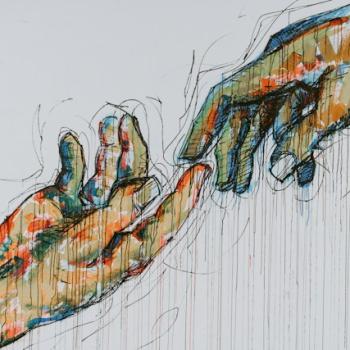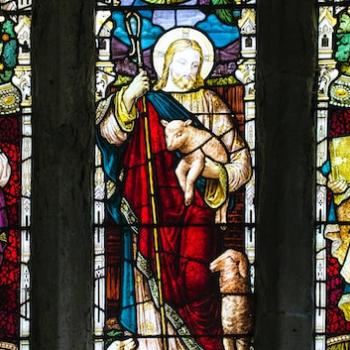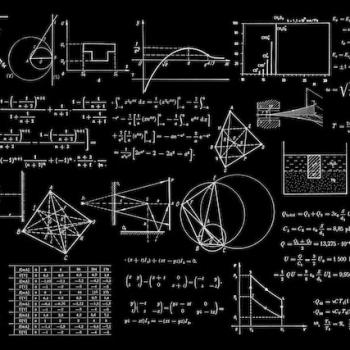The gospel reading for Holy Thursday points to the heart of the Christian message. Unfortunately, some of our religious language has clouded its impact.

As Gustav Flaubert wrote in Madame Bovary, “Human speech is like a cracked kettle on which we tap crude rhythms for bears to dance to, while we long to make music that will melt the stars.” He was right. Language is both treasure and torment at the same time.
We began this week grappling with the limitations of language of Christianity on Palm Sunday. Then on Monday of Holy Week, I suggested that “humanity” and “divinity” may be better understood as two modes of the same experience rather than binary opposites. T
On Tuesday of Holy Week, we explored the possibility of updating our definition of “God” in a way that makes sense in the modern world today. And here we are, Holy Thursday, the first day of the Triduum. For me, today’s gospel reading is one of the most important for understanding the Christian message.
Holy Thursday Truth
My previous posts suggested a truth that mystics and poets have intuited since the dawn of time – everything is all one thing. There is a divine unity that we may call God, Life, Ground of Being, Ultimate Reality, or any number of other terms. Ironically, this divine unity experiences itself in diversity. One body, many parts.
Science has verified this same truth. The universe as we know it began as a dynamic “singularity” which expanded and evolved and adapted over 16 billion years into the lives we live today. I find it fascinating that in today’s gospel reading, Jesus says this same truth. He knew “he had come from God and was returning to God” (John 13:3).
I believe the same is true for each of us. We came from God, we “live and move and have our being” (Acts 17:28) in God during our lives, and we return to God after we’ve drawn our last breath. At the Last Support on Holy Thursday, Jesus explains to his disciples what it means to “follow him.” He demonstrates the Christian message firsthand.
Jesus Washes His Diciples’ Feet
Before the Passover meal, Jesus removes his robe and wraps a simple towel around him. Then he pours water into a bowl and proceeds to wash his disciples’ feet. Peter is shocked at the idea that his teacher, his master, would lower himself to the tasks ordinarily assigned to the lowest in status.
But Jesus explains that if he doesn’t allow him to wash his feet, Peter will have no inheritance from him. True to form, Peter misses the point and says that if that’s the case, Jesus can bathe him all over. Jesus reigns in his exuberance.
Then Jesus tells the disciples what may be one of the most important passages in all of Scripture. “‘ Do you realize what I have done for you? You call me ‘teacher’ and ‘master,’ and rightly so, for indeed I am. If I, the master and teacher, have washed your feet, you ought to wash one another’s feet. I have given you a model to follow, so that as I have done for you, you should also do'” (12-15).
The Heart of the Christian Message
This is more than a moral prescription to be good and care for others. It’s a statement about the only logical way to engage in the world. If we are all part of one sacred unity, then we are all connected whether or not it appears that way on the surface. Therefore, caring for others isn’t just a nice thing to do; it’s enlightened self-interest!
Think about it. Why does it feel so good to hug someone you care about? Even more, why is sex so pleasurable? I think it’s because both acts are all about connection. Connection is how pieces of a whole approximate their original wholeness.
According to Jesus, the way to be his follower is to wash the feet of others. In other words, join. Care. Connect. Unite. Welcome. Gather. He distilled the entirety of the commandments, the wisdom of the prophets, and all of Jewish law with a simple directive: Love God and neighbor. Mic drop.
Organized religion has done a number on the heart of the Christian message. I guess “love God and neighbor” didn’t seem wordy enough to legitimize an entire institution. And we needed a way to identify “us” and “them” because “them” is no one we’d want to be. So, we came up with a zillion rules to follow. This lets us know who’s on Team Jesus and gives us a handy scorecard for judging the rest.
But Jesus wasn’t big on rules . . . unless we’re talking about his habit of breaking them. If I had a dollar for every time Jesus irked the Pharisees and Scribes by breaking a rule, I could retire tomorrow. Comfortably.
Holy Thursday is Simple, Not Easy
When all is said and done, the only real prescription for life as a follower of Jesus is to love. Loving my neighbor means recognizing the sacred unity within him and understanding that it’s the same that animates my own soul. I like how Eckart Tolle explains the concept: “Love is the recognition of oneness in the world of duality.” It’s how the diverse manifestations of a singular divine reality – God – reconnect to the sacred wholeness at their core.
Now, don’t get me wrong. I said Jesus’ message was simple, not easy. The violence, cruelty, discrimination, intolerance, and hatred we see across the globe on the news and in our own homes and communities provide more than enough evidence of the fact that humanity has a long way to go in recognizing that my neighbor is, well, me . . . on a level that human cognition has yet to apprehend.
But I’m hopeful. If, over billions of years, we evolved from single-celled organisms into humans who can now hug each other in any number of ways, then we’ve got a shot. Over the next several billion years, who knows? It could be fantastic.
Sin and Prayer
This worldview leads me to understand traditional religious language in novel ways. For me, then, sin is a word that describes anything that gets us out of alignment with the original wholeness from where we came. When we connect, join, gather, unite . . . we live out of this diving heritage. But when we cut off, lash out, judge, envy, and separate, we get out of alignment with our true nature. Just as a fish in a tank filled with distilled water will die because it lacks the necessary minerals, we too will get choked off by our choices to separate rather than connect.
I understand prayer, then, as anything that reminds me of my divine birthright, of the sacred unity of all of life. I could pray by attending Mass, praying the rosary, and saying an Our Father. I could also pray by taking a walk, listening to a friend, dancing alone to my favorite music, and observing something truly beautiful. Anything that helps me remember who and what I am is a prayer for me.
Human language is a marvel. But it’s also a minefield of danger. It giveth, and it taketh away. I think this Holy Thursday is a great time to remember who we really are and what the central Christian message truly is.












